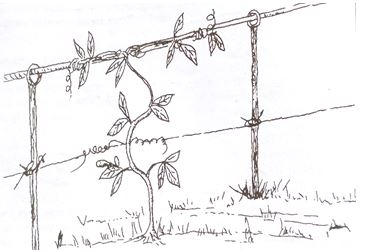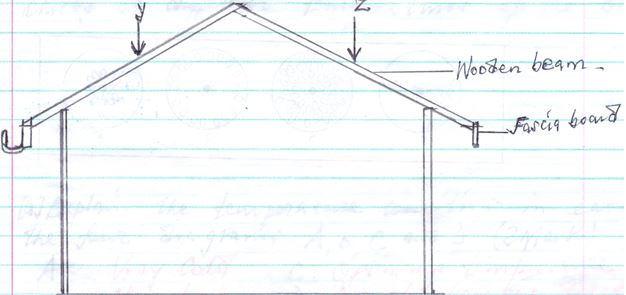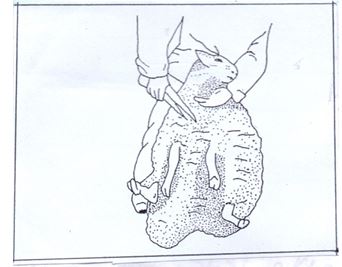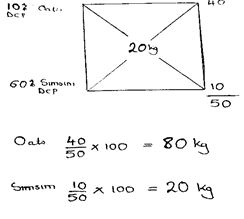Questions
INSTRUCTION TO CANDIDATES
- This paper consists of THREE section A, B and C
- Answer ALL the questions in section A and B and any one questions in section C.
SECTION A ( 30 Marks)
- What is the gestation period of the following animals (2 marks)
- Cow
- Sow
- Ewe
- Rabbit
- Differentiate between the following breed of livestock. (2 marks)
- New Zealand white and Californian white
- Large white and landrace
- State four characteristics of fertile soil (2marks)
- List four different type of drainage. (2marks)
- Name four reasons for carrying out minimum tillage. (2marks)
- State four precautions a farmer should take when using workshop tools. (2marks)
- State four ways in which the level of education and technology affects agriculture development in Kenya (2 marks)
- Name four types of livestock farming. (2marks)
- Stare four signs of parturition in goat. (2marks)
- Name four methods of identification in livestock. (2 marks)
- Name four methods of preserving fish. (2marks)
- State four symptoms caused by Round Worms in cattle. (2 marks)
- Name four factors that may predispose an animal to diseases. (2marks)
- Name any four common vegetables grown in Kenya. (2marks)
- List four post-harvesting practices. (2 marks)
SECTION B (50 MARKS)
-
- Differentiate between ruminant and non-ruminant. (6marks)
- Using the pearson’s square method, compute a 100kg ration with 20% DCP from Oats which contains 10% DCP and Simsim seed which containing 60% DCP. (4marks)
- The diagram below show a practice in crop production.
- Give the identity of the management practice illustrated above. (1mark)
- Give two reason for carrying out the above field management practice. (2mark)
- A plot measuring 4m X 3m was prepared for planting cabbages at a spacing of 60cm X60 cm. calculate the plant population in the plot. Show your working (3marks)
- A famer was advised to apply 150kg CAN/ha while topdressing the maize crop. CAN contains 21% N. Calculate the amount of Nitrogen applied per hectare (3marks)
- The drawing below shows the cross-section of a house under construction. Study it carefully and answer questions that follow.
- On the diagram, draw cross tie . (1mark)
- If timber was used to build the truss, why would it be important to season it.(2marks)
- State two importance of the fascia board in the farm building.(2marks)
- Name any six uses of crushes in livestock production. (6 marks)
- The illustration below shows a pig farrowing pen .Study it and answer questions that follow.
- What is the use of the raised metal rails. (1mark)
- Give two uses for the parts labeled D (2marks)
- Name seven sign of farrowing. (7 marks)
- Below is an illustration representing a practice carried out in sheep? Study it and answer questions that follow.
- Identify the practice illustrated above. (1mark)
- Name the tool used in the above practice (1mark)
- State three precautions taken when carrying out the above practice.(3marks)
- Name five methods used in docking. (5marks)
SECTION C (20 MARKS)
(Answer one question between 21 and 22)
- Describe the factors to consider when selecting a breeding stock (20marks)
- Discuss the process of egg formation in poultry (20 marks)
Marking Scheme
- What is the gestation period of the following animals (2 marks)
- Cow 270 to 285
- Sow 113 to 117
- Ewe 150
- Rabbit 28 to32
- Differentiate between the following breed of livestock. (2 marks)
- New Zealand white and Californian white
- New Zealand white is white and has red eyes while Californian white is white in colour with one or more of the following parts being black; ears, nose, paws and tail.
- Large white and landrace
- Large white- it is long, large and white pig skin may have a few blue spots.
- Landrace-white in colour
- New Zealand white and Californian white
- State four characteristics of fertile soil (2marks)
- Good depth
- Proper drainage
- Good water holding capacity
- Adequate nutrient supply
- Correct soil pH
- List four different methods of drainage. (2marks)
- Open ditches
- Underground drain pipes
- French drains
- Cambered beds
- Pumping
- Planting trees
- Name four reasons for carrying out minimum tillage. (2marks)
- To reduce the cost
- To control soil erosion
- To conserve moisture
- To prevent the disturbance of roots
- To prevent exposure of humus
- State four precautions a farmer should take when using workshop tools. (2marks)
- Tools should always be left in a safe place after use.
- Use the correct tool for the correct job.
- Tools should be maintained and serviced to remain in good working condition and last longer.
- Use of safety devices such as fire extinguishers and first aid kits in the workshop to reduce accidents.
- Tools should be handled correctly when in use to avoid damage to the tool and injury to the user.
- All tool should be stored properly in tool cabinets or in tool racks.
- State four ways in which the level of education and technology affects agriculture development in Kenya (2 marks)
- Proper methods and time of doing things such as planting at the right time and spacing
- Use of the type and the amount of input
- Applying the input at the right place
- Making right decisions based on the right observation
- Name four types of livestock farming. (2marks)
- Pastoralism
- Fish farming (aquaculture)
- Bee keeping (apiculture)
- Poultry keeping
- Stare four sign of parturition in goats. (2marks)
- The udder become firm and the tits enlarge
- The muscle at either side of the tail slacken
- Restlessness I s shown by pawing on the ground, rising up and lying down frequently
- Separating itself from the of the flock
- A clear discharge from the vulvar
- Name four methods of identification in livestock. (2 marks)
- Branding
- Tattooing
- Ear tagging
- Ear notching
- Neck trap or chain
- Name four methods of preserving fish. (2marks)
- Smoking
- Freezing
- Salting
- Sun drying
- State four symptoms caused by Round Warm in cattle (2 marks)
- Anorexia under heavy infestation
- Stiff dry coat or staring coat
- Dehydration and pale mucosa
- Eggs and adults are seen in faeces
- General emaciation
- Animal may have diarrhoea
- Pot-bellies especially young animals
- Anaemic conditions where infestation is heavy
- Name four factors that may predispose an animal to diseases. (2marks)
- Species of an animal
- Breed of an animal
- Age of an animal
- Sex of an animal
- Color of an animal
- Name any four common vegetables grown in Kenya. (2marks)
- Leaf vegetable.
- Root vegetable
- Tuber vegetable
- Fruit vegetable
- Stem vegetable
- Pod vegetable
- List four post-harvesting practices. 2 marks)
- Winnowing
- Threshing /shelling
- Drying
- Cleaning
- Sorting and grading
- Dusting
- Processing
- Packaging
-
- Differentiate between ruminant and non-ruminant. (6marks)
Ruminants Non ruminants Chew the cud
Four stomach chambers/polygastric
Regurgitating food
Can digest cellulose
No digestion in the mouth
Digestion and absorption take place in the rumen
Have alkaline salivaDo not chew cud
Monogastric
Food is swallowed once
Cannot digest cellulose
Digestion start in the mouth
Digestion and absorption take place in the small intestine
Neutral saliva - using the person’s square method to compute a 100kg ration with 20kg DCP from Oats which contains 10% DCP and Simsim seed which containing 60% DCP. (4marks)
- Differentiate between ruminant and non-ruminant. (6marks)
- The diagram below show a practice in crop production.
- Give the identity of the management practice illustrated above. (1mark)
- trelishing
- Give two reason for carrying out the above field management practice. (2marks)
- Facilitate easy carrying out of routine practices e.g. spraying
- Prevent soiling of fruits/clean fruits harvest
- Control fruits from being infected by soil borne pests
- Plant is well aerated
- A plot measuring 4m X 3m was prepared for planting cabbages at a spacing of 60cm X60 cm. calculate the plant population in the plot. Show your working (3marks)
- Plant population = (4mx100) x 3mx100
spacing 60cmx60cm =33+ 1
Award
1MF formula
1MF calculate
1M = Right answer
- Plant population = (4mx100) x 3mx100
- A famer was advice to apply 150kg CAN/ha while topdressing the maize crop. CAN contains 21% N. calculate the amount of nitrogen applied/ha (3marks)
- 150kg CAN supplied
100kg CAN = 21 kg/N
150kg = ?
21kg N x 150kg CAN
100kg CAN
= 31.5 n/ha
- 150kg CAN supplied
- Give the identity of the management practice illustrated above. (1mark)
- The drawing below shows the cross-section of a house under construction. Study it carefully and answer questions that follow.
- Assuming that the wooden beams are strong enough to hold the roof load .What is the most likely thing to happen when the roof load exerted presses at point Y and Z .(1mark)
- The span of the building expands at the top out wards;[
- On the diagram provided draw and label two constructional features you would add to this structure in order to make it more efficient.(2marks)
- Tie beam/cross tie;-Rafter batten;-Struts
- State two importance of the fascia board in the farm building.(2marks)
- Protects the rafter from attack by pests/disease/weather;-Attachment of gutters;-Add beauty to the structure
- Name any six uses of crushes in livestock production. (6 marks)
- Milking
- Hoof trimming
- Taking body temperature
- Artificial insemination
- Pregnancy test
- Dehorning
- Treating sick animal
- Vaccination
- Controlling
- Assuming that the wooden beams are strong enough to hold the roof load .What is the most likely thing to happen when the roof load exerted presses at point Y and Z .(1mark)
- The illustration below shows a pig farrowing pen .Study it and answer questions that follow.
- What is the use of the raised metal rails.(1mark)
- Protect the sow from lying/trampling on the piglets
- Give two uses for the parts labeled D(2marks)
- Dunging area;-Exercise area;-Basking area for piglets;-Resting area;
- Name seven sign of farrowing. (7 marks)
- Restlessness
- The vulvar turn red and swollen
- Udder become full with milk
- The sow start building nest
- Clear discharge of mucus from the vulvar
- Slackening of pelvic muscle
- Thick milk fluids from the tits
- What is the use of the raised metal rails.(1mark)
- Below is an illustration representing a practice carried out in sheep? Study it and answer questions that follow.
- Identify the practice illustrated above.(1mark)
- Wool shearing
- Name the tool used in the above practice (1mark)
- Wool shear
- State two precautions taken when carrying out the above practice.(2marks)
- Done during a dry season
- Care taken not to cut skin, testicles, udder, teats
- Name five methods used in docking. (5marks)
- Elastrator and rubber ring
- Burdizzo and knife
- Knife
- Hot iron
- Identify the practice illustrated above.(1mark)
- Describe the factors to consider when selecting a breeding stock (20marks)
- Age - Young animals, those that have parturated for not more than three times should be selected. This is because they have loner productive lives. Old animals are low producers and poor breeders. Production breeding eificiency declines with age.
- Level of performance - Only. those. animals with the highest production levels should be selected. Performance is best indicated by use of records. The performance of the relatives such as the ancestors should be checked to ascertain whether the animal belongs to a high producing family. There should a follow-up of the daughters to see whether they are also good producers. Good performance of an animal is indicated by high milk, wool and egg production, high growth rate, good mothering ability and generally high prepotency which is the ability of the parents to pass good qualities to their offspring. The animals with poor performance should be culled. Good records should, therefore, be kept and used by the farmer for this purpose.
- Physical fitness - Animals selected should the free from any physical defects such as being; mono-eyed, limping, irregular number of teats, scrotal hernia or defective and weak backline. It is likely that these traits could easily be passed to the offspring.
- Health - Animals selected must be healthy. Sick animals do not breed well and those falling sick frequently are expensive to keep. Animals that are resistant to diseases pass these characteristics to the offspring.
Body conformation -Animals for breeding should be selected according to their , proper body conformation. A dairy cow, for example, should be wedge-shaped with a large udder, thin legs, long neck and others. If, therefore, a dairy cow appears blocky, it should be culled.
Temperament or behaviour - Some animals within a breed might have bad temperament or undesirable behaviour such as cannibalism and egg eating in the case of poultry, aggressiveness and kicking in the case of dairy cattle. Such animals should be culled. - Quality of products - Select animal that give products of high quality. In wool production, for example, breeds that produce fine, long, elastic and pure white wool are selected.
Mothering ability -Animals selected should have a good mothering ability, that is, animals with good natural instinct towards their young ones . This will enable them to rear the young ones up to weaning. - Adaptability -Animals selected should be well adapted to the prevailing climatic conditions in the area.
- Prolificacy -Animals selected should be highly prolific, that is, animals with an ability to give birth to many offspring at a time(large litter). This is a quality that should be considered when selecting pigs and rabbits. All these factors ate considered when selecting cattle, sheep, goats, pip, rabbits and camels. When possible, available records of the ancestry performance with characteristics should be used.
- Discuss the process of egg formation in poultry (20 marks)
- The Ovary
A hen has two ovaries but only the left one is functional. Ova (eggs) are formed in the ovary. There are several thousands of ova in a hen, numbering about 3,500 to 4,000 Each ovum is held firmly by a protective device called a follicle. When the ovum (yolk) is mature, it is released from the ovary by the rapture of the follicle. It moves into the oviduct where it is received by the funnel. - The Funnel (Infundibulum)
When the ovum is moving down through the funnel, fertilisation takes place. At the same time chalazae are added to hold the yolk. The ovum stays here for about a quarter of an hour. The funnel is about 11.6 cm long. - Magnum
The yolk moves down to the magnum, where it stays here for three hours. The magnum is about 33 cm long. Isthmus - Isthmus
Isthmus section is about 10.6 cm long. When the yolk reaches here the shell membranes are added. Addition of the shell membranes determines the shape of egg. Water, mineral salts and vitamins are also added. It takes about a quarter of an hour for the egg to move from this region. - Uterus
This region has calcium deposits. Therefore, the shell is added round the egg. Shell pigments are also added. Addition of albumen is completed. The egg stays here for about 18 to 22 hours. - Vagina
This region is short and is about 6.9 cm long. The egg is temporarily stored here before it is laid. - Cloaca
The egg moves out of the cloaca through the vent. The cloaca extends out to prevent the egg from breaking. It should be noted that whether fertilisation takes place or not the egg will have to be formed. If fertilisation does not take place, the egg cannot hatch. The process of egg formation in a hen takes between 24 and 26 hours. Therefore, a hen is able to lay only one egg in a day. The components of an egg are obtained from the body reserves of a hen.
- The Ovary
Download Agriculture Questions and Answers - Form 3 Term 2 Opener Exams 2022.
Tap Here to Download for 50/-
Get on WhatsApp for 50/-
Why download?
- ✔ To read offline at any time.
- ✔ To Print at your convenience
- ✔ Share Easily with Friends / Students






